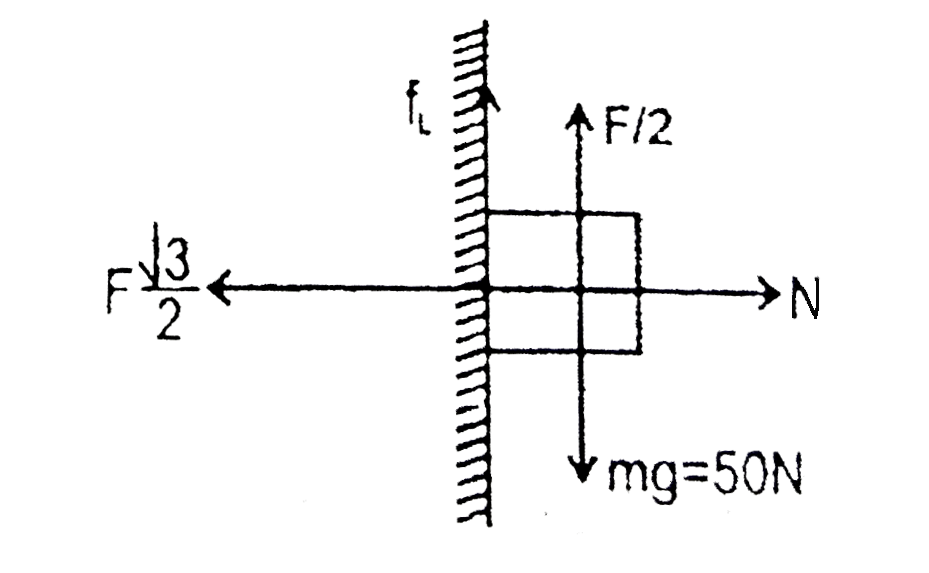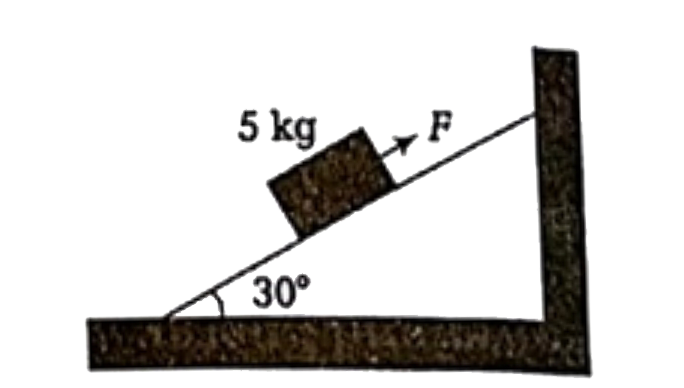A force F is applied on a block of mass 5kg as shown in figure. Co-efficient of friction between the wall and clock is √32.(g=10m/s2)

Select correct option(s)
Magnitude of minimum force F so that block doesn't slip on the wall is 40N.
Magnitude of minimum force F so that block doesn't slip on the wall is 20N.
If F<40N then block will side downwards
If F<40N then block will slide upwards
The correct Answer is:A, C
F2+μ(F√32)=50
⇒F2+F×34=50⇒5F4=50⇒F=40N

Topper's Solved these Questions
- TEST PAPERSBook:RESONANCEChapter:TEST PAPERSExercise:Physics
Explore 775 Videos
- TEST PAPERSBook:RESONANCEChapter:TEST PAPERSExercise:PT-01
Explore 30 Videos
- TEST PAPERSBook:RESONANCEChapter:TEST PAPERSExercise:PART - II PHYSICS SEC - 2
Explore 20 Videos
- SIMPLE HARMONIC MOTION Book:RESONANCEChapter:SIMPLE HARMONIC MOTION Exercise:Advanced Level Problems
Explore 13 Videos
- TEST SERIESBook:RESONANCEChapter:TEST SERIESExercise:PHYSICS
Explore 127 Videos
Similar Questions
A block of mass m = 2kg is accelerating by a force F = 20N applied on a smooth light pulley as shown in the figure. If the coefficient of kinetic friction between the block and the surface is μ=0.3, find its acceleration.

View SolutionA block of mass m is placed on another block of mass M lying on a smooth horizontal surface as shown in the figure. The co-efficient of friction between the blocks is μ. Find the maximum horizontal force F (in Newton) that can be applied to the block M so that the blocks together with same acceleration? (M=3kg,m=2kg,μ=0.1,g=10m/s2)

View Solution
Knowledge Check
A force F is applied on a block of mass 5kg as shown in figure. Co-efficient of friction between the wall and clock is √32.(g=10m/s2)

If 'f1 and 'f2' are magnitude of frictional force on the block when F=40N and F=140N repesctively. Then choose correct optionsAf1+f2=50NBf1f2=32Cf2−f1=90NDf1f2=35A force of 100N is applied on a block of mass 3kg as shown in the figure. The coefficient of friction between the surface and the block is μ=1√3 . The friction force acting on the bock is.
 A15N downwardB25N upwardC20N downwordD30N upward
A15N downwardB25N upwardC20N downwordD30N upwardA force of 100N is applied on a block of mass 3 kg as shown in the figure-2.164. The coefficient of friction between the surface and the block is 0.25.The frictional force acting on the block is: (Take g=10ms2)
 A15 N downwardsB25 N upwardsC20 N downwardsD30 N upwards
A15 N downwardsB25 N upwardsC20 N downwardsD30 N upwards
A force of 100N is applied on a block of mass 3kg as shown below. The coefficient of friction between wall and the block is 1/4. The friction force acting on the block is :

View SolutionTwo blocks A and B of mass 10 kg and 20 kg respectively are placed as shown in figure .Coefficient of friction between all the surface is 0.2 (g=10m/s2) Then,

View SolutionA wedge is moving rightwards on which a block of mass 10kg is placed on it. Friction coefficient between the wedge and the block is 0.8.[ takes g=10m/s2]. Select correct alternative (s) among the following options.

View SolutionA system is shown in figure. Blocks 2 & 3 kg are at rest then co-efficient of friction between 2 kg & incline is

View SolutionA force F=75 N is applied on a block of mass 5 kg along the fixed smooth incline as as shown in the figure. Here gravitational acceleration g = 10 m s−2 . The acceleration of the block is

View Solution

